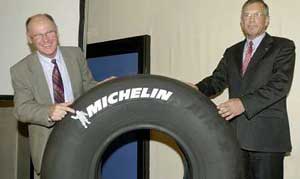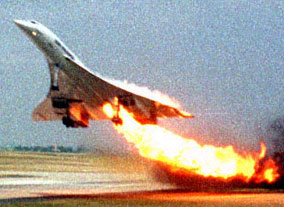| As
for the causes, let's start with the straightforward stuff .
The accident investigators concluded that Concorde ran over a piece of
titanium debris which fell from an aircraft which took off ahead of it.
The titanium burst a tyre, and a piece of the exploding tyre flew up into
the underside of the wing. This chunk of tyre pierced one of the in-wing
fuel-tanks, breaking an undercarriage wire in the process. The severed
wire caused a spark which ignited the fuel which was pouring out of the
hole in the tank.
To
regain the airworthiness certificate, British Airways and Air
France therefore had to demonstrate that such a sequence of events could
not occur again. This was tackled in three ways.
First,
the tyres. Normal tyres expand as speed increases. This means
that if a violent blow-out occurs, pieces of the tyre are thrown outwards
with considerable force. The Concorde engineers worked with Michelin to
develop a 'near-zero-growth' tyre: one that barely expands with speed.
Tests proved that when this tyre is burst, you don't get exploding fragments,
it simply deflates. The new tyres were also significantly lighter than
the old ones.

Second,
the wiring. All of the wiring surrounding the fuel-tanks was
armoured so that it is less likely to break due to an impact.
Third,
the fuel tanks. The bottom of several of the fuel tanks were
lined with rubber-kevlar shielding, both to reduce the risk of debris
reaching the fuel, and to dramatically reduce the rate at which fuel would
flow out through a leak.

Fitting the rubber-kevlar lining into one of
the fuel tanks inside the wing
The fuel tank liners added to the weight of the aircraft and also slightly reduced the volume of fuel that could be carried. However, thanks to lighter tyres, and the new seats fitted at the same time, the reduction in operating range was minimal. The new seats saved 1400kg (the weight of a typical car) by using a mixture of carbon-fibre, titanium and aluminium.
On 17th July 2001, the first Concorde with these modifications took off on a test flight. The Civil Aviation Authority returned Concorde's certificate of airworthiness on 5th September, the first passenger flight was on 7th November and normal daily service resumed on 9th December.
The full story of the crash may be more complex, however. A story in the Observer suggests that the root cause of the crash was faulty maintenance, compounded by sloppy procedures. The story alleged that two things went wrong before Concorde even reached the runway debris.
First, a spacer which holds the undercarriage wheels straight was not replaced after work on the undercarriage. This caused the wheels to wobble during the take-off roll and the two left-most wheels to lock up, resulting in Concorde veering to the left. It is suggested that it was the locked wheels rather than the runway debris that caused the tyre blow-out.
Second, Concorde was said to be significantly over the maximum take-off weight. Since taxiing out can take such a long time these days, airlines have to include taxiing fuel when calculating the total fuel required for the flight. That fuel of course adds to the initial weight of the aircraft, but will be burned up before take-off - so it is acceptable to push-back while above the maximum permitted take-off weight. But if the taxiing takes less time than expected, as happened with this Concorde flight, an aircraft may have to delay take-off until sufficient fuel has been burned. It is said that the Concorde flight-crew forgot about this and thus set off down the runway with too much fuel on board.
The combination of the two errors was what doomed the flight, argues the Observer. The sheering to the left meant that Concorde was about to leave the runway. Worse, it was about to veer into another aircraft on the ground. The pilots thus had no choice but to take off before the minimum take-off speed was reached. Had the aircraft not been over-weight, Concorde would have been able to achieve stable flight with only two of the four engines operating and might have made it back to the airport where fire-fighters may have enabled at least some of those on board to survive. But with too much weight and too little air-speed, she never stood a chance, claims the Observer. |


